MARKET OVERVIEW
The Global yerba mate market shall sail through a maze fashioned by regional standards, based on transparency on processing and documentation. Brands would then interface with third-party certifying practices to gain more from being trusted in an overcrowded bracket. Entry combinations and product claims will be affected by regulations concerning botanical imports, food safety, and organic certification.
With the changes in consumer attitude in favor of traditional, plant-based infusions with cultural heritage and functional value, the Global Yerba Mate sector will ensure that its presence is firmly established within the natural beverages and botanical extracts industries. In the social and well-being sector, yerba mate has been by tradition closely affiliated with South American cultures through which it draws from. Hence, the market has turned toward cultivating, processing, packaging, and distributing malamgo leaves and derivatives, depending largely on international consumer preferences and regulatory framework.
The leaves are harvested from the drying of the leaves and stems of the Ilex paraguariensis plant, native to countries like Argentina, Paraguay, Brazil, and Uruguay. While it was, in the past, consumed through traditional means of brewing, the Global yerba mate market will move beyond antiquated ways toward modernized forms of consumption: bottled beverages, ready-to-drink, energy drinks, and herbal tea blends becoming the cornerstone of product diversification. In an attempt to expand their portfolios in food and drink sectors, the industries will seek new ingredients, and as such, yerba mate will be elevated in recognition as a botanical ingredient of cultural relevance with possible benefits.
Processing standards and sourcing practices will determine the product differentiation levels in the Global yerba mate market. Manufacturers shall balance artisanal methods and larger industrial operations with authenticity when meeting demand. Geographic indications and traceability will become talked-about issues as consumers in the non-traditional markets grow increasingly fascinated about sourcing origin and ethics behind cultivation. With the entry of more players into this place, alongside flavor and strength-based differentiations, sustainable agriculture, and social initiatives working for the benefit of communities of indigenous growers will assume importance.
Market participants shall explore blends comprising yerba mate with specific complementary herbs, fruits, or botanical extracts, each varying with regional flavor expectations and dietary trends. The flexibility of yerba mate in cold brews, energy drinks, or functional supplements shall silently raise the gathered awareness for it, standing firmly as a plant with a rich legacy of communal sharing and nature itself. This dichotomized identity of being a contemporary wellness product and an aged, refreshing beverage shall be an elementary element in charting future branding endeavors for the Global yerba mate market.
The specialty retail trades, including agro-stores and local markets, will have variety distributions for mainstream retail channels and online health outlets. Packaging innovations will have an aesthetic value and affirm their commitments to sustainability; elements will include biodegradable materials and in-the-least-processing emphasis. On the other hand, global logistics in tune with e-commerce and a decentralized supply chain arena will have yerba mate producers get active in partnerships that guarantee freshness and uniformity across time zones.
A fusion of legacy and innovation positions the Global yerba mate market as a gateway to cultural authenticity and global consumer adaptation. While laying out the landscape, it will promote indigenous agricultural practices while finding marketing grounds within the health-conscious and experience-driven domains.
Global yerba mate market is estimated to reach $2,980.79 Million by 2032; growing at a CAGR of 5.2% from 2025 to 2032.
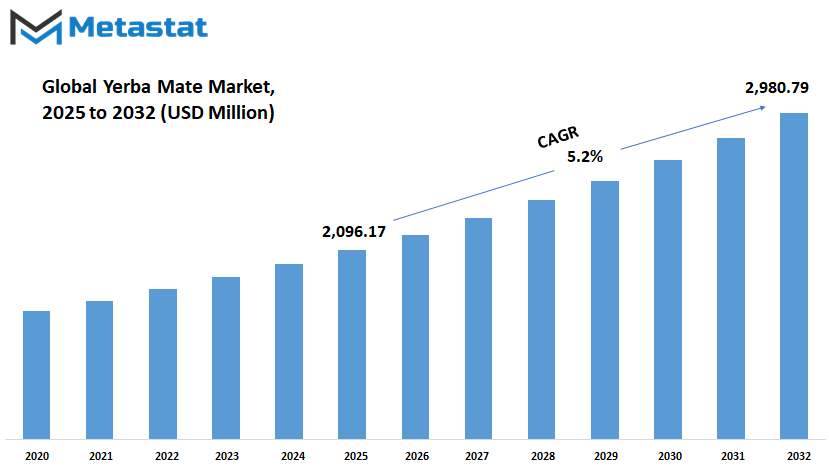
GROWTH FACTORS
The global yerba mate market should continue to settle down as new customers develop an interest in healthier alternatives to sustenance as opposed to conventional energy drinks and caffeinated drinks. The South American white wine, this traditional drink, has begun to fascinate the rest of the world due to its popularity as an energizing and wellness beverage. With more and more consumers focus on the health side of meals, the natural beverage option is picking up popularity. This change in demand continues to be a key driver of market growth. Thus, yerba mate exemplifies this trend as an herbal beverage traditionally believed to be good for one's health and to refresh. The primary driver of its demand is the recognition of its health value, including antioxidants, which are believed to prevent cell damage and maintain wellness.
It also provides caffeine in itself that is regarded as milder by some consumers than coffee or artificial energy drinks' stimulating properties. Due to such attributes, the drink has attracted many individuals as a prospect for part of an overall lifestyle. Such lifestyle shifts, particularly among young generations and health-oriented individuals, will be a driving force for the market. Despite this possibility, there are certain barriers that would prevent the speed at which the Global yerba mate market may grow. One of these barriers is that not much awareness of yerba mate exists outside South America.
For most countries, people are unaware of yerba mate or what to do with it. It becomes harder for companies to market their products. A further challenge presents itself from differences in food and drink legislation from one country to another. Labelling requirements and nutritional labels vary enormously and may lead to hold-ups or confusion for businesses looking to export into new markets. For all that, there are sound reasons for optimism that the market will accommodate new opportunities.
With increasing consumers turning to beverages that align with their desire for organic and ready-to-drink products, yerba mate is particularly well-positioned. Numerous new products are being created to address this demand, and it is becoming increasingly convenient for consumers to take yerba mate on the go. With increased education and stronger branding, demand worldwide could expand dramatically in the next few years. If companies can overcome the challenges facing them today, the future of the Global yerba mate market could be bright and promising, driven by a wellness and natural lifestyle focus.
MARKET SEGMENTATION
By Product Type
The Global yerba mate market will increase gradually, driven by health consciousness and consumer behavior. As more people turn to natural solutions for their daily lives, yerba mate is becoming popular due to its unique blend of energy-giving and antioxidant properties. This South American drink is now becoming increasingly popular worldwide, especially among people looking for plant-based and less processed options. The demand is driven by its appeal to youthful consumers who want something more than coffee or sugary beverages. Segmenting the Global yerba mate market on the basis of product type, it can be divided into traditional and organic. Traditional yerba mate continues to dominate through sheer availability and familiarity, but organic ones are gaining acceptance.
As people become more conscious of what they consume and drink, organic yerba mate demand is on the rise. This trend is only going to get stronger in the future, especially with more focus on clean-label products and sustainable agriculture. More and more consumers are scrutinizing product labels more closely and are willing to pay a premium for products with no chemicals or artificial additives. This will keep on stimulating companies to invest in organic certification and transparent sourcing. In the future, the market is USD 1,568.78 million and expected to expand to USD 527.40 million by 2025, showing great signs of consumer behavior shift. Markets outside South America, such as North America and some parts of Europe, are becoming increasingly interested in yerba mate.
This is primarily due to the rise in online sales, health-oriented promotions, and cultural interest. International trade and improved distribution networks are also contributing to taking this product to new locations.
In the years to come, the Global yerba mate market will be boosted by partnerships between small producers and big distributors. These connections will enable smaller farms to expand their market as well as provide businesses with access to more genuine and quality sources. Packaging innovation and variety of flavors will also contribute to assisting the market to grow. Since consumers will continue looking for drinks that promote wellness without artificial additions, yerba mate's popularity will increase.
Overall, the Global yerba mate market is poised for consistent growth. Its blend of tradition and flexibility makes it an attractive option in a world where individuals are looking for more natural and healthy beverage choices. With continued support from producers and consumers alike, its global reach will continue to expand.
By Form
The Global yerba mate market is slowly but surely picking up popularity in various regions of the globe, and it is set to grow steadily in the days to come. Yerba Mate, a South American beverage traditionally prepared from dried leaves of the Ilex paraguariensis plant, is now gaining entry into more homes and lives far from its native land. Although it's been popular in nations such as Argentina and Paraguay for ages, increasingly numbers of people from all over the world are intrigued by its naturally occurring energy benefits and possible wellness advantages. That change in customer interest is helping to dictate packaging, sales, and consumption for Yerba Mate, which impacts the direction in which the marketplace will go. One of the most apparent transitions within the Global Yerba Mate industry is in the range of product forms within which the offering now exists.
Historically served loose-leaf, such that individuals soak the dried leaf in hot water and drink by passing through a filtered straw, Yerba Mate no longer holds exclusivity within this form. Firms have also begun to make it in alternative formats, rendering it more accessible and convenient to consume. The tea bag format is now found in new customers who are perhaps not accustomed to the classic brew. Powder form is also taking hold, particularly with individuals blending it into a smoothie or adding it to recipes for increased energy and antioxidants. Ready-to-drink Yerba Mate is demonstrating robust growth, particularly in areas where bottled drinks are a part of everyday life. These items attract individuals who want a quick pick-me-up without the time or equipment required to make tea. Others available in the market, including Yerba Mate-based shots, functional beverages, and flavor-infused ones, are gradually surfacing. These new varieties indicate how businesses are testing to accommodate evolving tastes and hectic lifestyles. As lifestyles evolve and technology advances, the market for natural, plant-based products will probably grow. Individuals are becoming increasingly aware of what they eat and are looking toward beverages that provide function and tradition.
This places Yerba Mate at an advantage, as it provides a combination of culture and energy. The Global yerba mate market will probably witness a move towards more convenient and personalized choices that suit various requirements, ranging from wellness enthusiasts to corporate working professionals. The future will probably usher in more innovation while respecting the heritage of this special drink.
By Distribution Channel
The Global yerba mate market is gradually picking up pace as consumers continue to seek natural and functional drinks. Yerba Mate, the South American tea-like beverage, is now penetrating new parts of the world as there is an increasing interest in health-conscious lifestyles. Consumers are moving away from highly processed drinks and are increasingly open to alternatives that offer taste and potential health benefits. This shift will probably influence how Yerba Mate is purchased and consumed across regions. One of the most decisive factors for the future of such a market is how the product is being shipped.
The Global yerba mate market will continue to be divided by different channels, such as supermarkets and hypermarkets, convenience stores, online channels, and other retail options. Hypermarkets and supermarkets are likely to remain trendy as a result of their wide reach and ability to expose customers to new products. These shops generally have space to carry specialty items, so Yerba Mate becomes a more likelihood to be exposed to by sporadic buyers. Convenience stores, on the other hand, will continue to have a steady role to perform by offering Yerba Mate to people on the go. With ever speedier lifestyles, demand for quick-grab, healthier beverages will grow. Convenience stores are well-placed to offer single-serve formats that appeal to impulse buyers or those looking for a sudden shot of energy. Online retailing, however, will grow at an accelerated pace.
The Global yerba mate market will benefit from growing internet penetration, better delivery mechanisms, and the phenomenon of buying more items online. Consumers are going to enjoy the ease of browsing through multiple brands, reading reviews, and placing orders at home. Internet channels will also provide easier access for smaller Yerba Mate companies to more customers without occupying shelf space. In the future, it will be more convenient for most individuals to have their preferred Yerba Mate at home, especially with more subscription services and online offers on the rise.
Other channels, including local health food stores and wellness stores, will continue to sustain the market. These channels of stores encourage a sense of community and trust, which is helpful when bringing new products like Yerba Mate to market. Looking to the future, the Global yerba mate market will continue to grow as people turn to drinks that enhance their overall health. Supply channels will develop to keep pace with demand, using old and new measures to deliver to larger numbers of individuals this excellent and invigorating good.
|
Forecast Period |
2025-2032 |
|
Market Size in 2025 |
$2,096.17 million |
|
Market Size by 2032 |
$2,980.79 Million |
|
Growth Rate from 2025 to 2032 |
8.0% |
|
Base Year |
2024 |
|
Regions Covered |
North America, Europe, Asia-Pacific, South America, Middle East & Africa |
REGIONAL ANALYSIS
The Global yerba mate market shows signs of growth that stretch beyond current trends, with regional differences playing a key role in shaping how this growth will unfold. In the future, the market will not just expand in size but also in how it adapts to local preferences, cultural habits, and health trends. Each region brings something unique to the table, making the future of this market more interesting and diverse.
In North America, awareness of natural products and plant-based energy sources will continue to rise. As people become more health-conscious, Yerba Mate will find its place as a daily alternative to more traditional beverages. The United States will likely drive this shift, supported by Canada’s steady interest and Mexico’s deeper historical connection to herbal infusions. Over time, more consumers in these areas will look for products that give both flavor and function, and Yerba Mate checks both boxes.
Europe will also play an important part. Countries such as Germany, France, and the UK are showing growing curiosity about global wellness trends. Yerba Mate fits well into this movement, especially among younger buyers who often seek out sustainable and ethically sourced drinks. The market in Europe may expand steadily as local producers and importers start to introduce a wider range of Yerba Mate products. With time, even places in the rest of Europe, which are just getting familiar with it, will catch on.
Asia-Pacific is a region to watch closely. With countries like China and India at the forefront of consumer demand, the potential here is vast. People in this area are already familiar with tea culture, so the introduction of Yerba Mate as a new but similar option could go smoothly. Over the next few years, creative marketing and product variations suited to local tastes will likely help this market gain ground.
South America will remain a stronghold. Yerba Mate is not new here; it's deeply rooted in daily life in countries like Argentina and Brazil. However, the future focus may shift toward premium and export-friendly versions of the product. As global demand grows, South America will be a key supplier, possibly refining production methods to meet international standards.
In the Middle East the Global yerba mate market is displaying growth that extends beyond the trends of today, with regional variations leading the way in determining what this future growth looks like. The market will not only grow in terms of size but also in terms of how it acculturates to local tastes, cultural traditions, and wellness trends. Each region has something unique to offer, which makes the future of this market more varied and intriguing.
North America will see the awareness of natural products and herbal energy sources increasing. With increased health awareness, Yerba Mate will establish itself as a daily substitute for more conventional drinks. The United States will spearhead this movement with Canada's consistent interest and Mexico's greater cultural affinity to herbal infusions. In time, more consumers within these regions will seek out products that provide both taste and functionality, and Yerba Mate qualifies on both fronts. Europe will also have a significant role to play.
Germany, France, and the UK are among countries that are increasingly interested in worldwide wellness trends. Yerba Mate is well positioned within this trend, particularly with younger consumers who tend to be looking for sustainable and ethically produced beverages. The European market can grow steadily as domestic producers and importers begin to launch a greater variety of Yerba Mate products. With the passage of time, even locations in the remainder of Europe, which are yet to become familiar with it, will pick up. Asia-Pacific is a region to keep an eye on. With China and India leading consumer demand, the potential here is enormous. Consumers in this region are already used to tea culture, so introducing Yerba Mate as a new but comparable choice could go down well.
Creative marketing and product variations tailored to local tastes will probably assist this market in gaining traction over the next few years. South America will still be a strong bastion. Yerba Mate isn't unfamiliar here; it's part and parcel of day-to-day living in nations like Brazil and Argentina. Still, future attention will increasingly go to high-end and export-quality variations of the item. With international demand expanding, South America will become an important exporter and may adjust the ways they make the item in line with foreign demands.
In Africa and the Middle East, the market is in an earlier stage. Nevertheless, increasing urbanization and a youth population provide a promising foundation. As more individuals pursue healthier lifestyles, Yerba Mate may increasingly gain traction here as well, particularly in nations seeking to diversify their wellness product offerings.
and Africa, the market is at an early stage. Still, rising urbanization and a growing youth population offer a promising base. With more people seeking healthier lifestyles, Yerba Mate could steadily gain attention here too, especially in countries looking to expand their range of wellness products.

COMPETITIVE PLAYERS
The Global Yerba Mate industry will likely experience significant changes with the increasing number of consumers worldwide seeking healthier and natural options as substitutes for daily beverages. Originally most popular in South American nations, yerba mate is gradually receiving more prominence all over the globe. Individuals are increasingly discovering its stimulating impact and health benefits, and this growing demand will probably drive both production and competition in the forthcoming years. With demand reaching new geographies, the competition between the existing players in the market also will become more competitive.
Existing players with strong foundations, including Las Marías, Amanda, Playadito, Taragüi, and Selecta, will dominate as they possess a long-standing heritage and well-established product quality. These companies have been perfecting their processes for decades, gaining customers' trust, and developing blends suitable for various palates. Their ongoing success will rest upon how well they adapt to shifting global preferences and the requirements of newer markets. In the meantime, newer companies and brands such as Mate Factor, ECOTEAS, and Guayakí are bringing novel approaches. Their models tend to be focused on organic production, sustainability, and a more contemporary image.
These players don't necessarily have the same long history as some, but they are gaining attention with their innovative branding and commitment to sustainability. They concentrate on appealing to young consumers who are concerned about the origin of their food and beverages, and how these affect the planet. With the Global yerba mate market growing, innovation will become a significant factor in determining competition. Brands may start introducing new flavors, easy-to-use packaging, or even ready-to-drink versions to suit the lifestyle requirements of various consumers.
There is also increasing demand for functional drinks that aid energy, concentration, or digestion and yerba mate is a natural fit in that area. Brands that can effectively position their offerings in this segment will be ahead. Looking ahead, the businesses that develop strongest in this market will be those who remain true to their heritage while at the same time remaining open to change. It could be through improved agricultural methods, intelligent advertising, or greater distribution, the future of the Global yerba mate market will depend on how effectively these industry leaders react to change and continue to address changing requirements of a global community.
Yerba Mate Market Key Segments:
By Product Type
- Conventional
- Organic
By Form
- Loose Leaf
- Tea Bags
- Powder
- Ready-to-Drink
- Others
By Distribution Channel
- Supermarkets/Hypermarkets
- Convenience Stores
- Online Retail
- Others
Key Global Yerba Mate Industry Players
- Las Marías
- Amanda
- Playadito
- Taragüi
- Selecta
- La Tranquera
- Barão
- Triunfo
- Mate Factor
- ECOTEAS
- Guayakí
WHAT REPORT PROVIDES
- Full in-depth analysis of the parent Industry
- Important changes in market and its dynamics
- Segmentation details of the market
- Former, on-going, and projected market analysis in terms of volume and value
- Assessment of niche industry developments
- Market share analysis
- Key strategies of major players
- Emerging segments and regional growth potential



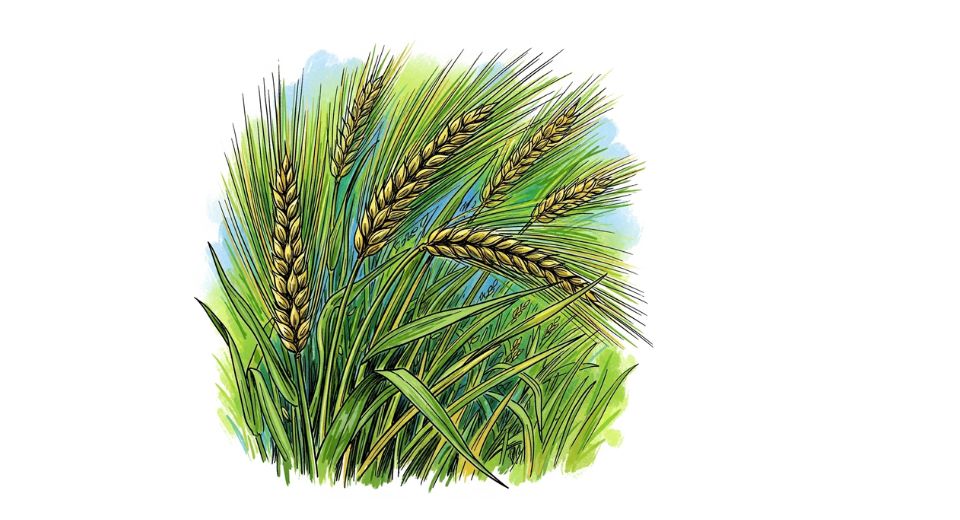
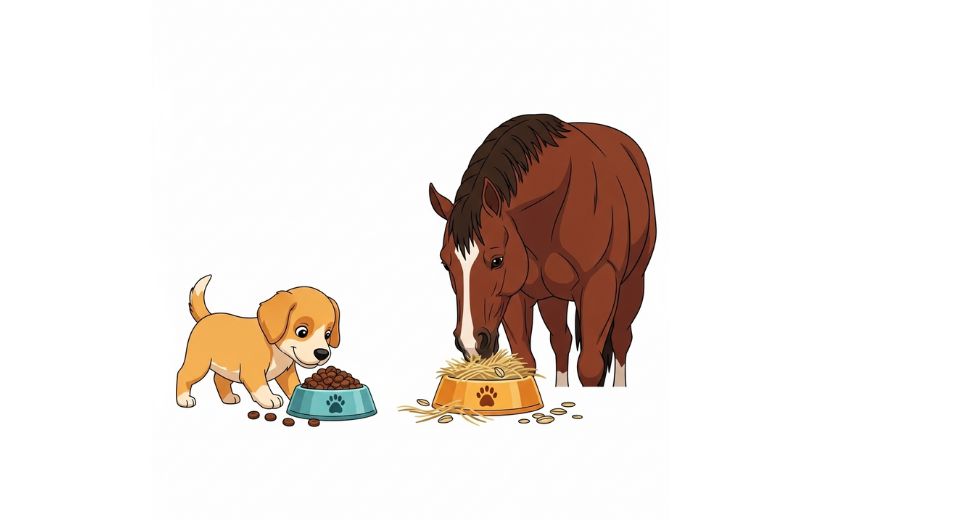
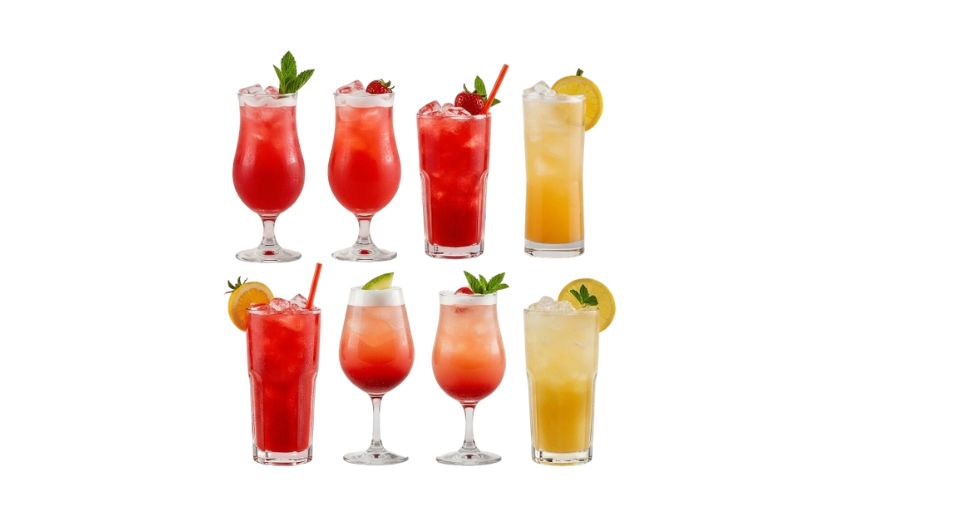
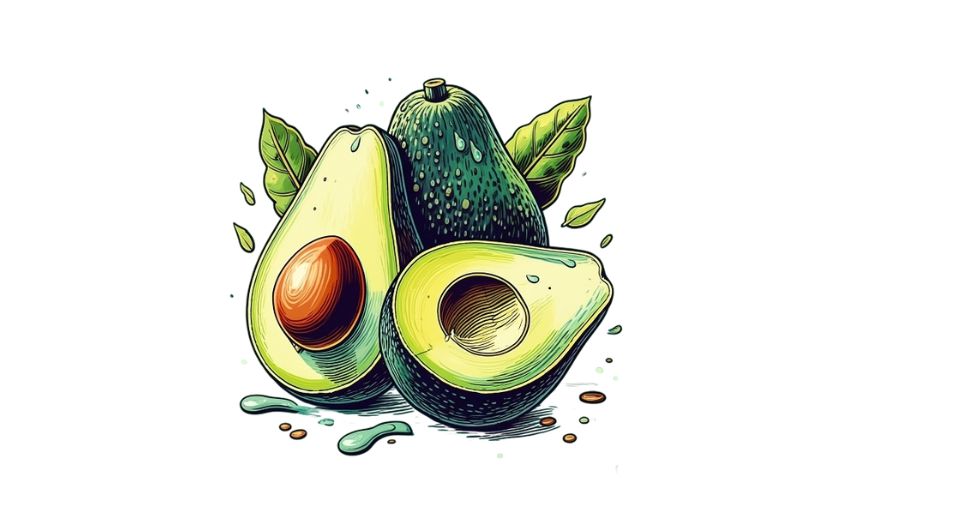

 US: +1 3023308252
US: +1 3023308252






